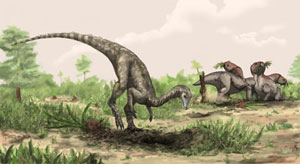A creature about the size of a Labrador retriever with a 1.5-metre-long tail could be the earliest-known dinosaur to have walked the Earth, according to scientists.Research published Wednesday in the journal Biology Letters describes a set of fossilized bones from Tanzania that predates all other discoveries by 10 to 15 million years.

The Nysasaurus parringtoni, which stood upright, measured two to three metres from head to tail and weighed between 20 to 60 kilograms. It would have lived during the Middle Triassic period, about 245 million years ago. (Mark Witton/Natural History Museum
The new findings suggest that dinosaurs evolved earlier than previously thought — in the Middle rather than Late Triassic period.
The creature, which stood upright, measured two to three metres from head to tail and weighed between 20 to 60 kilograms. It would have lived during the Middle Triassic period, about 245 million years ago.
“If the newly named Nysasaurus parringtoni is not the earliest dinosaur, then it is the closest relative so far,” said Sterling Nesbitt, a paleontologist at the University of Washington.
The species was named in honour of Rex Parrington, who collected the specimens – an upper arm bone and six vertebrae — in the Ruhuhu Basin in southern Tanzania. Although the fossils were discovered in the 1930s, they had not been studied until now.
Earlier evolution
The bones reveal that N. parringtoni shared common characteristics with other dinosaurs and their close relatives, such as rapid growth.
“The bone tissue of Nysasaurus is exactly what we would expect for an animal at this position on the dinosaur family tree,” said University of California’s Sarah Warning, who did the bone analysis.
“It’s a very good example of a transitional fossil; the bone tissue shows that Nysasaurus grew about as fast as other primitive dinosaurs, but not as fast as later ones,” she said.
Nesbitt says the discovery has important implications if the species is indeed a dinosaur. “It establishes that dinosaurs likely evolved earlier than previously expected and refutes the idea that dinosaur diversity burst onto the scene in the Late Triassic, a burst of diversification unseen in any other groups at that time,” he said.
The Triassic period extended from about 250 million to 200 million years ago, following a so-called “Great Dying” event that triggered the extinction of more than 90 per cent of Earth’s species. The period saw the emergence of new creatures, including the first mammals.
The researchers suggest that dinosaurs were just another part of that gradual diversification.
The discovery is also noteworthy because the location of the fossils supports the hypothesis that dinosaurs originated in the southern parts of the prehistoric supercontinent of Pangaea. The remains of the oldest-known relative of the dinosaur, the Asilisaurus kongwe, were also discovered in southern Tanzania in 2007.



 December 7th, 2012
December 7th, 2012  Riffin
Riffin  Posted in
Posted in  Tags:
Tags: 